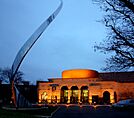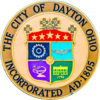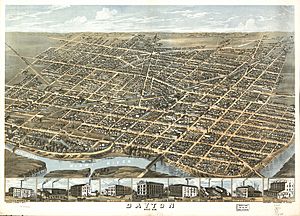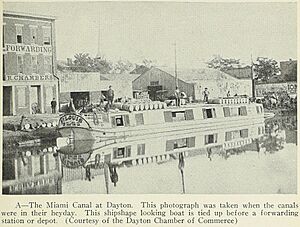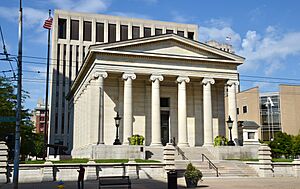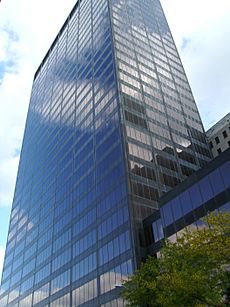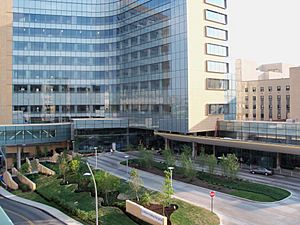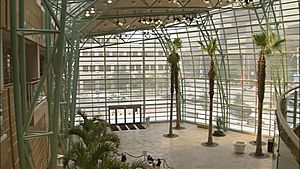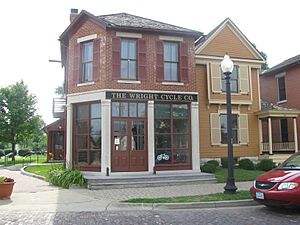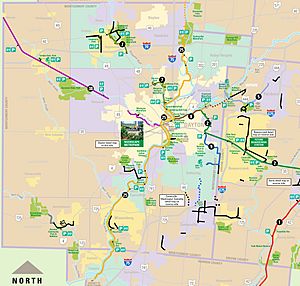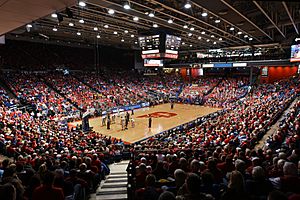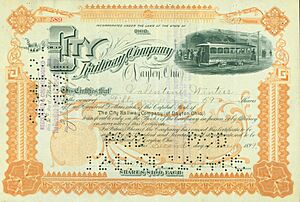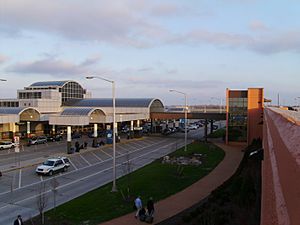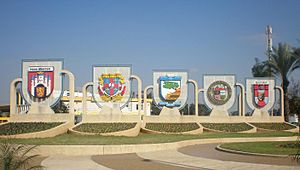Dayton, Ohio facts for kids
Quick facts for kids
Dayton
|
|||||
|---|---|---|---|---|---|
|
|||||
| Nickname(s):
The Gem City, Birthplace of Aviation
|
|||||
| Country | United States | ||||
| State | Ohio | ||||
| County | Montgomery | ||||
| Founded | 1796 | ||||
| 1841 (city) | |||||
| Named for | Jonathan Dayton | ||||
| Area | |||||
| • City | 56.96 sq mi (147.52 km2) | ||||
| • Land | 55.81 sq mi (144.54 km2) | ||||
| • Water | 1.15 sq mi (2.99 km2) | ||||
| Elevation | 742 ft (226 m) | ||||
| Population
(2020)
|
|||||
| • City | 137,644 | ||||
| • Estimate
(2023)
|
135,512 | ||||
| • Density | 2,466.47/sq mi (952.31/km2) | ||||
| • Urban | 674,046 (US: 64th) | ||||
| • Urban density | 2,107.1/sq mi (813.6/km2) | ||||
| • Metro | 814,049 (US: 73rd) | ||||
| Time zone | UTC−5 (EST) | ||||
| • Summer (DST) | UTC−4 (EDT) | ||||
| ZIP Codes |
ZIP codes
|
||||
| Area codes | 937, 326 | ||||
| FIPS code | 39113 | ||||
| GNIS feature ID | 1086167 | ||||
Dayton is a city in Ohio, United States. It is located in the Miami Valley region. About 137,000 people live in Dayton. It is the sixth-largest city in Ohio. The larger Dayton area has over 814,000 residents. Dayton is about 50 miles north of Cincinnati. It is also 60 miles west of Columbus. The city is the county seat of Montgomery County.
Dayton was founded in 1796. It is named after Jonathan Dayton, an important figure in early American history. He owned a lot of land in the area. In the 1800s, Dayton grew as a canal town. It became famous for its many inventions and inventors. The most famous inventors were the Wright brothers. They created the first successful motor-powered airplane. Later, Dayton became a center for factories. It was also part of the Manhattan Project during World War II. This project helped develop parts for early atomic bombs. Today, Dayton's businesses are more diverse. They focus on services like healthcare and technology.
Ohio is close to a large part of the country's population. This makes Dayton a key place for moving goods. The city is home to Wright-Patterson Air Force Base. This base is very important for research in aviation and space. Besides defense and aerospace, healthcare is a big part of Dayton's economy. Important places in Dayton include the National Museum of the United States Air Force and the University of Dayton.
Contents
- Discovering Dayton: A City of Innovation and History
- Dayton's Landscape: Geography and Climate
- Dayton's Economy: Jobs and Innovation
- Dayton's Culture: Arts, Entertainment, and Food
- Staying Active: Parks, Recreation, and Sports
- Learning in Dayton: Schools and Universities
- Dayton in the News: Media and Transportation
- Dayton's Global Connections: Sister Cities
- Notable People from Dayton
- See also
Discovering Dayton: A City of Innovation and History
How Dayton Began: Early Settlers and Growth
Dayton was founded on April 1, 1796. Twelve settlers, called the Thompson Party, arrived by boat. They traveled up the Great Miami River from Cincinnati. They found two small camps of Native Americans there. Benjamin Van Cleve, one of the settlers, wrote about early life in the Ohio Valley. The oldest building still standing is Newcom Tavern. It was used for many things, including Dayton's first church.
In 1797, Daniel C. Cooper built Mad River Road. This was the first land route connecting Cincinnati and Dayton. Ohio became a state in 1803. Dayton became a village in 1805 and a city in 1841. The city was named after Jonathan Dayton. He was a captain in the American Revolutionary War. He also signed the United States Constitution. In 1827, work began on the Dayton–Cincinnati canal. This canal made it easier to move goods. It helped Dayton's economy grow a lot in the 1800s.
Dayton's Spirit of Invention: The Birthplace of New Ideas
Dayton has a long history of new ideas and inventions. In 1884, John Henry Patterson bought a company that made cash registers. He started the National Cash Register Company (NCR). This company made the first mechanical cash registers. It helped Dayton become known for manufacturing in the early 1900s. In 1906, Charles F. Kettering helped create the first electric cash register. NCR also helped with the US Navy Bombe. This machine helped break secret codes during World War II.
Dayton has been home to many inventions since the 1870s. In 1890, Dayton had more patents per person than any other U.S. city. The Wright brothers, who invented the airplane, were from Dayton. Charles F. Kettering, famous for his many inventions, also lived here. James Ritty invented the first mechanical cash register in Dayton. Arthur E. Morgan developed a flood prevention system here. Paul Laurence Dunbar, a famous African-American poet, wrote his best works in Dayton.
Dayton: Where Aviation Took Flight
Powered flight began in Dayton. Orville and Wilbur Wright built and tested their first airplane here. Their first flight was in Kitty Hawk, North Carolina. But their plane, the Wright Flyer, was built in Dayton. They brought it back to Dayton for more tests. These tests happened at Huffman Field, a field near the current Wright-Patterson Air Force Base.
During World War I, the Army bought land next to Huffman Prairie. This became the Fairfield Aviation General Supply Depot. As planes got better, they needed more space. So, a new location was found. Local businessmen raised money to buy land. This land included Wilbur Wright Field and Huffman Prairie Flying Field. Wright Field was officially opened on October 12, 1927. After World War II, several airfields merged. They became Wright-Patterson Air Force Base. This base is still very important today.
Overcoming Challenges: The Great Dayton Flood
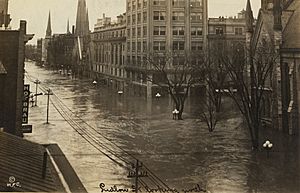
In March 1913, a huge flood hit Dayton. It was called the Great Dayton Flood. This disaster led to the creation of the Miami Conservancy District in 1914. This district built a series of dams and pumps. These systems help protect Dayton from floods today.
Dayton's Role in World War II and Beyond
Dayton played a big part in World War II. Several places in the city were part of the Dayton Project. This project was a small part of the larger Manhattan Project. It helped create parts for early atomic bombs. The war led to a boom in manufacturing. Many people moved to Dayton for jobs. This caused a shortage of housing. Emergency housing was built, and some of it is still used today.
After the war, from the 1940s to the 1970s, many people moved to the suburbs. Veterans came home looking for factory jobs. New buildings and highways made it easier to live outside the city. More than 127,000 homes were built in Montgomery County in the 1950s.
Since the 1980s, Dayton's population has gone down. This is mostly because many factory jobs were lost. Also, people continued to move to the suburbs. Despite this, Dayton has been working to grow new types of jobs. These include jobs in healthcare and education.
Making Peace: The Dayton Agreement
In 1995, a very important peace agreement happened near Dayton. It was called the Dayton Agreement. This agreement helped end the war in Bosnia and Herzegovina. Leaders from different countries met at Wright-Patterson Air Force Base. They worked together from November 1 to 21 to create the peace plan.
People in Dayton were very proud to be part of this historic event. Signs at the airport called Dayton the "temporary center of international peace." Local newspapers and TV stations covered the story closely. People gathered to pray for peace. They even formed a "peace chain" outside the base.
Dayton Today: A City Renewed
Since the 2000s, downtown Dayton has been growing. Day Air Ballpark, home of the Dayton Dragons baseball team, was built in 2000. This minor league team is very popular. In 2001, Five Rivers MetroParks opened RiverScape MetroPark. This outdoor area attracts over 400,000 visitors each year. A new performing arts center, the Schuster Center, opened in 2003. Miami Valley Hospital also added a large new tower.
In 2010, the Greater Downtown Dayton Plan was started. This plan focuses on creating jobs and improving the city. It also works on housing, recreation, and teamwork. The plan aims to make Dayton even better by 2020.
Dayton's Special Names: The Gem City and More
Dayton is known as the "Gem City." No one is completely sure how it got this name. One idea is that a famous racehorse named Gem was from Dayton in the early 1800s. In 1845, a writer called Dayton "the gem of all our interior towns." They said Dayton had "wealth, refinement, enterprise, and a beautiful country."
Later, a newspaper editor named William D. Bickham pushed for the "Gem City" nickname. The city's Board of Trade adopted the name. The poet Paul Laurence Dunbar even mentioned it in his poem, "Toast to Dayton." He wrote that Dayton "shines—the brightest gem."
Ohio is called the "Birthplace of Aviation." This is because the Wright brothers were from Dayton. They invented and built the first practical airplane. After their first flights in Kitty Hawk, North Carolina, they came back to Dayton. They continued testing their planes at Huffman Prairie.
Dayton is also sometimes called "Little Detroit." This nickname comes from Dayton's history as a major manufacturing center.
Dayton's Landscape: Geography and Climate
Dayton covers about 56.5 square miles. Most of this area is land, with a small amount of water.
Dayton's Weather: Summers, Winters, and Storms
Dayton has warm, humid summers and cold, dry winters. This type of weather is called a humid continental climate. The average temperature in January is about 29 degrees Fahrenheit. In July, it's about 76 degrees Fahrenheit. The hottest temperature ever recorded was 108 degrees Fahrenheit in 1901. The coldest was -28 degrees Fahrenheit in 1899.
Dayton gets about 25 inches of snow each year. This usually happens from November to March. The city also gets about 41 inches of rain annually. May is usually the wettest month.
Dayton can experience severe weather. Tornadoes are possible from spring to fall. Floods, blizzards, and strong thunderstorms can also happen. In May 2019, Dayton was hit by a series of tornadoes. One was an EF4 tornado, which caused a lot of damage. It tore through several communities. Many homes lost power and water.
| Climate data for Dayton, Ohio (Dayton International Airport), 1991–2020 normals, extremes 1893–present | |||||||||||||
|---|---|---|---|---|---|---|---|---|---|---|---|---|---|
| Month | Jan | Feb | Mar | Apr | May | Jun | Jul | Aug | Sep | Oct | Nov | Dec | Year |
| Record high °F (°C) | 75 (24) |
76 (24) |
87 (31) |
90 (32) |
98 (37) |
102 (39) |
108 (42) |
103 (39) |
102 (39) |
94 (34) |
79 (26) |
72 (22) |
108 (42) |
| Mean maximum °F (°C) | 58.6 (14.8) |
63.0 (17.2) |
71.9 (22.2) |
80.4 (26.9) |
86.6 (30.3) |
91.9 (33.3) |
92.7 (33.7) |
91.8 (33.2) |
89.4 (31.9) |
82.3 (27.9) |
69.7 (20.9) |
61.3 (16.3) |
94.1 (34.5) |
| Mean daily maximum °F (°C) | 37.1 (2.8) |
41.2 (5.1) |
51.5 (10.8) |
64.5 (18.1) |
74.2 (23.4) |
82.6 (28.1) |
85.9 (29.9) |
84.6 (29.2) |
78.6 (25.9) |
66.2 (19.0) |
52.7 (11.5) |
41.5 (5.3) |
63.4 (17.4) |
| Daily mean °F (°C) | 29.4 (−1.4) |
32.8 (0.4) |
42.1 (5.6) |
53.7 (12.1) |
64.0 (17.8) |
72.7 (22.6) |
76.0 (24.4) |
74.5 (23.6) |
67.7 (19.8) |
56.0 (13.3) |
44.1 (6.7) |
34.3 (1.3) |
53.9 (12.2) |
| Mean daily minimum °F (°C) | 21.8 (−5.7) |
24.5 (−4.2) |
32.7 (0.4) |
42.9 (6.1) |
53.8 (12.1) |
62.7 (17.1) |
66.1 (18.9) |
64.3 (17.9) |
56.8 (13.8) |
45.9 (7.7) |
35.4 (1.9) |
27.1 (−2.7) |
44.5 (6.9) |
| Mean minimum °F (°C) | −1.7 (−18.7) |
4.0 (−15.6) |
13.4 (−10.3) |
25.2 (−3.8) |
37.4 (3.0) |
48.7 (9.3) |
53.9 (12.2) |
52.1 (11.2) |
41.9 (5.5) |
30.2 (−1.0) |
19.4 (−7.0) |
7.4 (−13.7) |
−4.6 (−20.3) |
| Record low °F (°C) | −25 (−32) |
−28 (−33) |
−7 (−22) |
15 (−9) |
26 (−3) |
40 (4) |
44 (7) |
40 (4) |
30 (−1) |
18 (−8) |
−2 (−19) |
−20 (−29) |
−28 (−33) |
| Average precipitation inches (mm) | 3.08 (78) |
2.35 (60) |
3.50 (89) |
4.46 (113) |
4.51 (115) |
4.14 (105) |
3.95 (100) |
2.96 (75) |
3.31 (84) |
2.95 (75) |
3.07 (78) |
3.05 (77) |
41.33 (1,050) |
| Average snowfall inches (cm) | 8.3 (21) |
6.6 (17) |
3.9 (9.9) |
0.4 (1.0) |
0.0 (0.0) |
0.0 (0.0) |
0.0 (0.0) |
0.0 (0.0) |
0.0 (0.0) |
0.2 (0.51) |
0.8 (2.0) |
4.8 (12) |
25.0 (64) |
| Average precipitation days (≥ 0.01 in) | 13.4 | 11.3 | 12.1 | 13.0 | 14.1 | 11.9 | 10.6 | 8.1 | 8.6 | 9.5 | 9.9 | 11.8 | 134.3 |
| Average snowy days (≥ 0.1 in) | 7.6 | 6.4 | 3.2 | 1.0 | 0.0 | 0.0 | 0.0 | 0.0 | 0.0 | 0.2 | 1.2 | 4.9 | 24.5 |
| Average relative humidity (%) | 72.7 | 72.0 | 69.5 | 64.2 | 65.1 | 66.0 | 68.8 | 71.5 | 71.9 | 69.3 | 73.3 | 75.8 | 70.0 |
| Mean monthly sunshine hours | 134.0 | 136.6 | 178.4 | 213.2 | 263.1 | 293.7 | 296.2 | 277.4 | 237.6 | 192.9 | 115.7 | 99.9 | 2,438.7 |
| Percent possible sunshine | 45 | 46 | 48 | 54 | 59 | 65 | 65 | 65 | 64 | 56 | 39 | 34 | 55 |
| Source: NOAA (relative humidity and sun 1961–1990) | |||||||||||||
| Climate data for Dayton, Ohio (Miami Conservancy District, downtown), 1991–2020 normals, extremes 1893–present | |||||||||||||
|---|---|---|---|---|---|---|---|---|---|---|---|---|---|
| Month | Jan | Feb | Mar | Apr | May | Jun | Jul | Aug | Sep | Oct | Nov | Dec | Year |
| Record high °F (°C) | 75 (24) |
77 (25) |
88 (31) |
90 (32) |
98 (37) |
103 (39) |
108 (42) |
105 (41) |
102 (39) |
93 (34) |
81 (27) |
72 (22) |
108 (42) |
| Mean maximum °F (°C) | 60.8 (16.0) |
65.8 (18.8) |
74.9 (23.8) |
83.7 (28.7) |
90.5 (32.5) |
95.5 (35.3) |
96.9 (36.1) |
95.9 (35.5) |
93.1 (33.9) |
85.0 (29.4) |
72.1 (22.3) |
63.4 (17.4) |
98.0 (36.7) |
| Mean daily maximum °F (°C) | 36.3 (2.4) |
40.2 (4.6) |
50.7 (10.4) |
64.3 (17.9) |
74.9 (23.8) |
83.6 (28.7) |
86.7 (30.4) |
85.8 (29.9) |
79.2 (26.2) |
66.1 (18.9) |
52.0 (11.1) |
40.9 (4.9) |
63.4 (17.4) |
| Daily mean °F (°C) | 28.2 (−2.1) |
31.4 (−0.3) |
40.6 (4.8) |
52.9 (11.6) |
63.9 (17.7) |
73.0 (22.8) |
76.2 (24.6) |
74.8 (23.8) |
67.5 (19.7) |
54.8 (12.7) |
42.6 (5.9) |
33.2 (0.7) |
53.3 (11.8) |
| Mean daily minimum °F (°C) | 20.1 (−6.6) |
22.6 (−5.2) |
30.6 (−0.8) |
41.4 (5.2) |
52.9 (11.6) |
62.4 (16.9) |
65.7 (18.7) |
63.9 (17.7) |
55.8 (13.2) |
43.5 (6.4) |
33.1 (0.6) |
25.6 (−3.6) |
43.1 (6.2) |
| Mean minimum °F (°C) | 1.7 (−16.8) |
7.2 (−13.8) |
15.2 (−9.3) |
27.5 (−2.5) |
39.2 (4.0) |
51.0 (10.6) |
57.0 (13.9) |
55.5 (13.1) |
44.5 (6.9) |
31.9 (−0.1) |
21.8 (−5.7) |
10.6 (−11.9) |
−0.7 (−18.2) |
| Record low °F (°C) | −21 (−29) |
−28 (−33) |
0 (−18) |
15 (−9) |
28 (−2) |
37 (3) |
45 (7) |
37 (3) |
29 (−2) |
18 (−8) |
0 (−18) |
−16 (−27) |
−28 (−33) |
| Average precipitation inches (mm) | 3.17 (81) |
2.35 (60) |
3.54 (90) |
4.45 (113) |
4.38 (111) |
4.41 (112) |
4.03 (102) |
3.12 (79) |
3.03 (77) |
3.00 (76) |
3.04 (77) |
3.13 (80) |
41.65 (1,058) |
| Average snowfall inches (cm) | 6.9 (18) |
1.5 (3.8) |
1.7 (4.3) |
0.0 (0.0) |
0.0 (0.0) |
0.0 (0.0) |
0.0 (0.0) |
0.0 (0.0) |
0.0 (0.0) |
0.0 (0.0) |
0.1 (0.25) |
2.1 (5.3) |
12.3 (31) |
| Average precipitation days (≥ 0.01 in) | 12.2 | 10.1 | 11.4 | 13.0 | 13.5 | 12.1 | 10.0 | 8.3 | 8.0 | 9.3 | 9.5 | 11.0 | 128.4 |
| Average snowy days (≥ 0.1 in) | 4.1 | 2.3 | 0.8 | 0.0 | 0.0 | 0.0 | 0.0 | 0.0 | 0.0 | 0.0 | 0.2 | 2.3 | 9.7 |
| Source: NOAA | |||||||||||||
Dayton's City Design: Architecture and Neighborhoods
Dayton has wide, straight downtown streets. This made it easy to get around, even when cars became popular. The streets were originally wide for wagons pulled by many oxen. Some streets were once canals with paths for barges.
The Old Montgomery County Courthouse was built in 1847. It is a beautiful building. Many presidents have visited it, including Abraham Lincoln. He gave a speech there in 1859.
The Dayton Arcade opened in 1904. It was meant to replace outdoor markets. It has a unique Flemish style and a glass dome. The Arcade is currently being fixed up.
Dayton's two tallest buildings are the Kettering Tower and the KeyBank Tower. Kettering Tower is 408 feet tall. KeyBank Tower is 385 feet tall.
Dayton has ten historic neighborhoods. These include the Oregon District and Wright Dunbar. They have many old houses and mansions. These buildings show different styles of architecture. Downtown Dayton is also a large area with many neighborhoods. It has been growing and improving recently.
Dayton's Economy: Jobs and Innovation

Dayton's economy is strong and diverse. It is important to the state of Ohio. Site Selection magazine ranked Dayton as a top city for economic development. Dayton is also good at exporting goods to other countries. The city has a lot of water, which helps attract new businesses.
Bloomberg Businessweek said Dayton is one of the best places for college graduates to find jobs. Many companies have their main offices in Dayton. These include CareSource and LexisNexis. NCR, a big computer technology company, used to be based here for over 125 years.
Research and New Technologies
The Dayton region is known for aviation and aerospace technology. In 2009, Ohio named Dayton its aerospace innovation hub. Two major U.S. research groups are based here. They are the National Air and Space Intelligence Center (NASIC) and the Air Force Research Laboratory (AFRL). Both are at Wright-Patterson Air Force Base.
Many research groups support these organizations. The University of Dayton Research Institute (UDRI) is one of them. Dayton has also started Tech Town. This project helps attract technology companies to the downtown area. It even has the world's first business incubator for RFID technology.
Healthcare in Dayton
Healthcare is a huge part of Dayton's economy. The Kettering Health Network and Premier Health Partners are major employers. Hospitals in the Dayton area employ almost 32,000 people. They have a big economic impact, bringing in billions of dollars each year. Many Dayton hospitals are ranked among the best in the U.S. These include Miami Valley Hospital and Kettering Medical Center.
Dayton also has special health centers. The Center for Tissue Regeneration and Engineering at Dayton studies how to regrow human tissue. The National Center for Medical Readiness (NCMR) trains people for disasters. Its facility, Calamityville, is a disaster training site.
Dayton's Culture: Arts, Entertainment, and Food
Art and Performances
Dayton is a great place for arts and culture. American Style magazine ranked Dayton as one of the top art cities in the U.S. The Dayton Art Institute is a famous art museum.
The Benjamin and Marian Schuster Performing Arts Center is a world-class venue. It is home to the Dayton Philharmonic Orchestra, Dayton Opera, and Dayton Ballet. It also hosts concerts, lectures, and Broadway shows. The historic Victoria Theatre also hosts many performances. The Loft Theatre is home to the Human Race Theatre Company.
Dayton has several ballet companies. The Dayton Ballet is one of the oldest professional dance companies in the U.S. The Dayton Contemporary Dance Company is also well-known. It has the largest collection of African-American contemporary dance in the world.
Fun and Entertainment
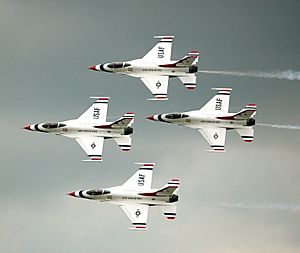
The Vectren Dayton Air Show is an exciting annual event. It takes place at the Dayton International Airport. It is one of the biggest air shows in the United States.
Five Rivers MetroParks offers many outdoor activities. It has over 14,000 acres of parks. These parks offer recreation, education, and conservation. The MetroParks also maintains over 70 miles of paved trails. These trails connect different counties.
Dayton was a hub for funk music in the 1970s and 1980s. Bands like Ohio Players and Zapp were from here. Dayton also gave rise to indie and punk bands like The Breeders.
The Oregon District is a historic area downtown. It has art galleries, shops, pubs, and coffee houses.
Dayton hosts many yearly festivals. These include the Dayton Celtic Festival and the Dayton Blues Festival. There are also festivals for urban culture, jazz, reggae, and Hispanic heritage.
Dayton's Delicious Food
Dayton has great restaurants. The Pine Club is a nationally known steakhouse. Dayton is also famous for its unique Dayton-style pizza. This pizza has a thin, crispy crust. It's dusted with cornmeal and has a thin layer of unsweetened sauce. The toppings go all the way to the edge. The pizza is cut into small squares. Famous local pizza places include Cassano's and Marion's Piazza.
Other local food companies include Esther Price Candies. This company makes candy and chocolate. Mike-sells is the oldest potato chip company in the U.S. In recent years, Dayton has also become known for its many breweries and craft beer spots.
Places to Visit: Tourism in Dayton
Tourism is a big part of Dayton's economy. One out of every 14 jobs in the county is related to tourism. The most popular tourist spot is the National Museum of the United States Air Force. It is at Wright-Patterson Air Force Base. This museum is the largest and oldest military aviation museum in the world. It gets over 1.3 million visitors each year. It is one of Ohio's most visited attractions. The museum also houses the National Aviation Hall of Fame.
Other museums are also important for tourism. The Dayton Art Institute has over 20,000 art objects. It was named one of the top 10 best art museums for children. The Boonshoft Museum of Discovery is a science museum for kids. It has many exhibits, including an indoor zoo with nearly 100 animals.
Dayton also has historical museums. The Dayton Aviation Heritage National Historical Park celebrates the Wright brothers and Paul Laurence Dunbar. The Wright brothers' famous Wright Flyer III airplane is at Carillon Historical Park. America's Packard Museum has many restored old cars. SunWatch Indian Village/Archaeological Park is a reconstructed 12th-century Native American village. It shows how people lived long ago.
Staying Active: Parks, Recreation, and Sports
Dayton was named National Geographic's outdoor adventure capital of the Midwest in 2019. This is because of its parks, bike trails, and green spaces.
Five Rivers MetroParks has 340 miles of paved trails. This is the largest network of off-street trails in the U.S. These trails make up over 35% of Ohio's total off-street trail network. In 2010, the city of Troy was named "bike friendly" by the League of American Bicyclists.
Sports Teams and Venues
Dayton has several sports teams and college programs.
| Club | League | Sport | Venue | Established |
|---|---|---|---|---|
| Dayton Dragons | Midwest League | Baseball | Day Air Ballpark | 2000 |
| Gem City Roller Derby | Women's Flat Track Derby Association | Roller Derby | Dayton Convention Center | 2006 |
| Dayton Dutch Lions | USL League Two | Soccer | DOC Stadium | 2009 |
| Dayton Flyers | NCAA Division I | (multiple) | Welcome Stadium (Football), University of Dayton Arena (Basketball), Thomas J. Frericks Center (Volleyball), Woerner Field (Baseball) |
1903 |
| Wright State Raiders | NCAA Division I | (multiple) | Ervin J. Nutter Center (Basketball), Alumni Field (Soccer), Nischwitz Stadium (Baseball) |
1968 |
| Dayton Area Rugby Club | Midwest Division II | Rugby Union Rugby Sevens |
Dayton Rugby Grounds | 1969 |
The Dayton Dragons baseball team is a minor league team for the Cincinnati Reds. They are famous for selling out every game. They hold the record for the longest sellout streak in professional sports.
The University of Dayton and Wright State University both have NCAA basketball teams. The University of Dayton Arena has hosted more NCAA men's basketball tournament games than any other place. It is also where the First Round games of the NCAA Tournament are played.
Dayton hosted the first American Professional Football Association game. This league later became the NFL. The game was played in 1920 between the Dayton Triangles and the Columbus Panhandles.
The Dayton area has many golf courses. Several PGA Championships have been held here. These include the 1945 PGA Championship at Moraine Country Club.
Learning in Dayton: Schools and Universities
Public Schools in Dayton
Dayton Public Schools runs 34 schools. They serve over 16,000 students. Some high schools include:
- Belmont High
- Paul Laurence Dunbar High
- Stivers School for the Arts
Private Schools in Dayton
Dayton has more than 35 private schools. Some of these are:
- Chaminade Julienne Catholic High School
- Dayton Christian School
- The Miami Valley School
Colleges and Universities
Forbes magazine ranked the Dayton area as one of the top places for higher education in the U.S. The city has two main universities. The University of Dayton is a private, Catholic school. It was founded in 1850. It has the only law school in the Dayton area. It is also Ohio's largest private university. The University of Dayton Research Institute is known for its research.
Wright State University became a state university in 1967. It has the National Center for Medical Readiness. This program trains people for disaster relief. Wright State's Boonshoft School of Medicine is the only medical school in the Dayton area. It is a leader in medical research.
Dayton is also home to Sinclair Community College. It is the largest community college in Ohio at one location. Sinclair is known as one of the best community colleges in the country. It started as the YMCA college in 1887.
Other schools near Dayton include Antioch College in Yellow Springs. The Air Force Institute of Technology is at Wright-Patterson Air Force Base. It is a graduate school for the United States Air Force.
Dayton in the News: Media and Transportation
News and Media
Dayton's main newspaper is The Dayton Daily News. It is the only daily newspaper in the city. The Dayton Business Journal covers local business news. The Dayton Weekly News provides news for Dayton's African-American community.
There are also many magazines about the Dayton area. The Dayton Magazine covers arts, food, and events.
Television and Radio
Dayton has many TV stations. These include channels for NBC, CBS, PBS, ABC, Fox, and The CW. Dayton also has many AM and FM radio stations.
Getting Around Dayton: Public Transit and Highways
The Greater Dayton Regional Transit Authority (RTA) runs public buses. Dayton also has electric trolley buses. The Dayton trolleybus system has been running since 1933. It is one of the oldest in the U.S.
Dayton has a Greyhound Station for bus travel to other cities.
Airports in Dayton
Dayton International Airport offers flights to many cities. It served almost 3 million passengers in 2008. It is also a big hub for air cargo. Companies like FedEx Express and UPS Airlines use it.
The Dayton area also has smaller airports. The Dayton–Wright Brothers Airport is for private and corporate planes.
Major Roads and Highways
Dayton is served by three major interstates:
- Interstate 75 runs north to south through Dayton.
- Interstate 70 runs east to west. It crosses I-75 north of the city. This meeting point is called "Freedom Veterans Crossroads." I-70 is the main road to the airport.
- Interstate 675 is a partial ring road around Dayton's eastern suburbs.
Other important roads include US 35. This highway cuts through the city. State Route 4 is a freeway that is used a lot.
From 2010 to 2017, I-75 through downtown Dayton was rebuilt and widened. This was a huge project.
Trains in Dayton
Dayton has several freight train terminals. Two large railroad companies, CSX and Norfolk Southern Railway, operate here.
Passenger trains used to stop at Dayton Union Station. The last long-distance passenger train left in 1979.
Dayton's Global Connections: Sister Cities
Dayton has "sister cities" around the world. These partnerships help build friendships and understanding. Dayton's sister cities are:
- Sarajevo, Bosnia and Herzegovina
- Augsburg, Germany
- Holon, Israel
- Monrovia, Liberia
- Ōiso, Japan
- Rushmoor, England
Notable People from Dayton
Many famous people have come from Dayton, Ohio!
See also
 In Spanish: Dayton (Ohio) para niños
In Spanish: Dayton (Ohio) para niños




